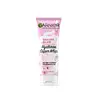Clean & Clear Essentials Foaming Oil-Free Facial Cleanser Versus Garnier Sakura Glow Hyaluron Super Whip Foam
What's inside
What's inside
 Key Ingredients
Key Ingredients

 Benefits
Benefits

 Concerns
Concerns

 Ingredients Side-by-side
Ingredients Side-by-side

Water
Skin ConditioningTriethanolamine
BufferingMyristic Acid
CleansingC9-15 Alkyl Phosphate
CleansingLauric Acid
CleansingGlycerin
HumectantHydroxypropyl Methylcellulose
Emulsion StabilisingCocamidopropyl Betaine
CleansingPhenoxyethanol
PreservativeParfum
MaskingMethylparaben
PreservativeBHT
AntioxidantPropylparaben
PreservativeEthylparaben
PreservativeCI 14700
Cosmetic ColorantSolvent Yellow 33
Water
Skin ConditioningSorbitol
HumectantLauric Acid
CleansingStearic Acid
CleansingMyristic Acid
CleansingPotassium Hydroxide
BufferingGlycol Distearate
EmollientPalmitic Acid
EmollientKaolin
AbrasiveSodium Cocoamphoacetate
CleansingCoco-Betaine
CleansingCI 14700
Cosmetic ColorantCI 16035
Cosmetic ColorantLinalool
PerfumingNiacinamide
SmoothingParfum
MaskingSodium Chloride
MaskingSodium Hyaluronate
HumectantSodium Palmitoyl Proline
Skin ConditioningSodium Benzoate
MaskingPhenoxyethanol
PreservativePrunus Yedoensis Leaf Extract
Skin ConditioningDisodium EDTA
Limonene
PerfumingAscorbyl Glucoside
AntioxidantNymphaea Alba Flower Extract
Skin ConditioningHydroxypropyl Methylcellulose
Emulsion StabilisingCitronellol
PerfumingCapryloyl Salicylic Acid
ExfoliatingDipropylene Glycol
HumectantPolyquaternium-7
Butylene Glycol
HumectantBenzyl Alcohol
PerfumingBenzyl Salicylate
PerfumingWater, Sorbitol, Lauric Acid, Stearic Acid, Myristic Acid, Potassium Hydroxide, Glycol Distearate, Palmitic Acid, Kaolin, Sodium Cocoamphoacetate, Coco-Betaine, CI 14700, CI 16035, Linalool, Niacinamide, Parfum, Sodium Chloride, Sodium Hyaluronate, Sodium Palmitoyl Proline, Sodium Benzoate, Phenoxyethanol, Prunus Yedoensis Leaf Extract, Disodium EDTA, Limonene, Ascorbyl Glucoside, Nymphaea Alba Flower Extract, Hydroxypropyl Methylcellulose, Citronellol, Capryloyl Salicylic Acid, Dipropylene Glycol, Polyquaternium-7, Butylene Glycol, Benzyl Alcohol, Benzyl Salicylate
 Reviews
Reviews

Ingredients Explained
These ingredients are found in both products.
Ingredients higher up in an ingredient list are typically present in a larger amount.
Ci 14700, also known as Red No. 4, is a synthetic red dye derived from petroleum. It is water soluble.
This ingredient is a semi-synthetic polymer created from cellulose. In case you need a refresher, cellulose is the main component of plant cell walls.
Hydroxypropyl Methylcellulose has many uses:
- emulsifier
- create a gel-like texture
- boost foam
Lauric Acid is a fatty acid or lipid. About half of fatty acids in coconut oil is lauric acid.
This ingredient helps hydrate and sooth skin. As a humectant, it helps trap moisture. It also aids in cleaning and enhancing the texture of products.
Lauric acid may not be Malassezia folliculitis, or fungal acne, safe.
Learn more about Lauric AcidMyristic Acid is a saturated fatty acid. It is naturally found in milk fat. Other sources include palm oil, coconut oil, and butter fat.
Myristic Acid is an emulsifer and cleanser. As an emulsifer, it stabilizes a product by preventing ingredients from separating. Myristic Acid helps clean your skin by acting as a surfactant. It tends to gather oil and dirt on your skin to be easily rinsed away.
One study from 2021 found Myristic Acid to have anti-inflammatory properties.
Learn more about Myristic AcidParfum is a catch-all term for an ingredient or more that is used to give a scent to products.
Also called "fragrance", this ingredient can be a blend of hundreds of chemicals or plant oils. This means every product with "fragrance" or "parfum" in the ingredients list is a different mixture.
For instance, Habanolide is a proprietary trade name for a specific aroma chemical. When used as a fragrance ingredient in cosmetics, most aroma chemicals fall under the broad labeling category of “FRAGRANCE” or “PARFUM” according to EU and US regulations.
The term 'parfum' or 'fragrance' is not regulated in many countries. In many cases, it is up to the brand to define this term.
For instance, many brands choose to label themselves as "fragrance-free" because they are not using synthetic fragrances. However, their products may still contain ingredients such as essential oils that are considered a fragrance by INCI standards.
One example is Calendula flower extract. Calendula is an essential oil that still imparts a scent or 'fragrance'.
Depending on the blend, the ingredients in the mixture can cause allergies and sensitivities on the skin. Some ingredients that are known EU allergens include linalool and citronellol.
Parfum can also be used to mask or cover an unpleasant scent.
The bottom line is: not all fragrances/parfum/ingredients are created equally. If you are worried about fragrances, we recommend taking a closer look at an ingredient. And of course, we always recommend speaking with a professional.
Learn more about ParfumPhenoxyethanol is a preservative that has germicide, antimicrobial, and aromatic properties. Studies show that phenoxyethanol can prevent microbial growth. By itself, it has a scent that is similar to that of a rose.
It's often used in formulations along with Caprylyl Glycol to preserve the shelf life of products.
Water. It's the most common cosmetic ingredient of all. You'll usually see it at the top of ingredient lists, meaning that it makes up the largest part of the product.
So why is it so popular? Water most often acts as a solvent - this means that it helps dissolve other ingredients into the formulation.
You'll also recognize water as that liquid we all need to stay alive. If you see this, drink a glass of water. Stay hydrated!
Learn more about Water